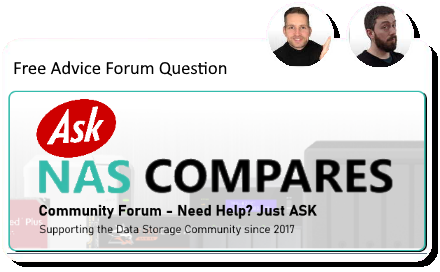Posts: 1,079
Threads: 1,080
Joined: Feb 2020
Reputation:
2
Hello, I'm building a NAS server for personal use- I've started collecting my own movie/show/music so I'm not relying on streaming- and am looking to use as much of my own leftover tech as possible. Here's what I have:
1TB Toshiba HDD
1TB Western Digital Blue HDD
500GB Seagate HDD
500GB Samsung 500GB SSD
1 Dell Optiplex 3070 Micro with an i3 8100T, 128GB M2 SSD, Intel UHD 630 integrated graphics, Intel Wireless-AC 9560, and an external PSU
(https://dl.dell.com/topicspdf/optiplex-3070-desktop_owners-manual5_en-us.pdf)
Ideally, I'd like to use as much as possible from the Optiplex as possible. I'm willing to get a new case obviously, likely a Jonsbo, but if I'm able to keep the motherboard that'd be ideal. The problem is, it only accommodates 1 SATA 3.0. I've watched some of your videos on DIY NAS, but I was wondering what advice you have for someone in my specific situation.
Let me know if you need any more info/pictures! Thanks!
Posts: 5,338
Threads: 2
Joined: Jun 2022
Reputation:
35
Thanks for laying out your hardware, that makes it much clearer. The Dell Optiplex 3070 Micro is a solid little machine, but as you’ve already spotted, the limitation is the single SATA port. Out of the box it’s fine for running a single system drive, but not enough for multiple HDDs in a NAS-style build.
You have a few paths you could take:
1. Use it as a NAS “head” with external storage
You could attach a multi-bay USB enclosure (like a Yottamaster or TerraMaster DAS) and pass those drives through to TrueNAS SCALE or Unraid running on the Optiplex. Not as clean as native SATA, and performance tops out at USB 3.0 speeds, but it lets you reuse what you have without major cost.
2. Add more storage via PCIe (with adapters)
The 3070 Micro does have an M.2 slot and limited PCIe options. There are adapters that convert M.2 to multiple SATA ports, or even to a mini-SAS breakout card. These are not as reliable as a proper HBA card, but if you’re aiming for “$0 spend,” it’s a potential hack to add more drives. Just know support can be hit and miss.
3. Repurpose the Optiplex as a Plex/management server and build storage separately
Since the i3-8100T with UHD 630 supports Intel Quick Sync, it’s actually pretty good for Plex or Jellyfin transcoding. You could keep this system as your media server host and point it to a dedicated NAS chassis for storage (for example, a Jonsbo N1/N2/N3 build with an inexpensive HBA card and your mixed drives). This way you make use of the Optiplex’s CPU for playback and containers, while giving yourself proper SATA expandability in a dedicated case.
Because your drives are mismatched (two 1TB, one 500GB, one 500GB SSD), you won’t get much out of traditional RAID. Something like Unraid is a better fit, since it allows mixing drive sizes and still provides parity protection. TrueNAS ZFS, by contrast, expects matched drives and won’t be efficient here.
So, the simplest setup with what you have:
• Run Unraid or TrueNAS SCALE on the Optiplex.
• Use a USB DAS or an M.2-to-SATA expansion adapter to attach multiple drives.
• Treat the 500GB SSD as a cache or app drive.
• Use the Optiplex CPU for Plex/Jellyfin (Quick Sync works well).
If you decide to spend a bit down the road, a proper 4–8 bay NAS case (like Jonsbo N3) plus an HBA card will give you a much cleaner and faster setup, but for now the Optiplex is absolutely workable as a starter build.





